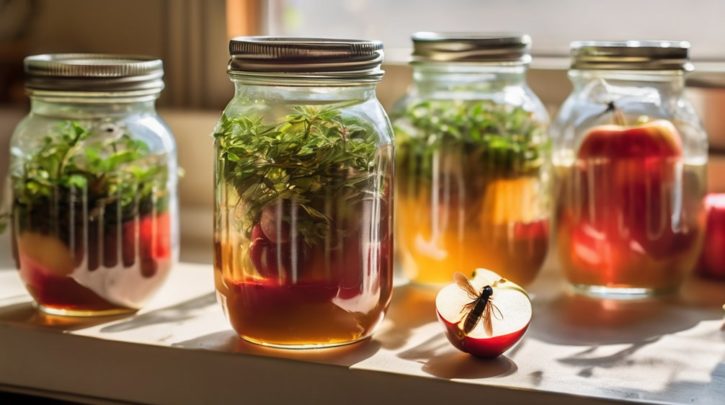To effectively trap fruit flies, choose traps that use bait like apple cider vinegar combined with dish soap to lure and capture flies without harming the environment. Look for designs with narrow openings or sticky surfaces to prevent escape. Placing traps near infested spots and regularly renewing bait improves success. You can also create homemade traps using simple ingredients and containers. Proper placement, maintenance, and bait selection are key factors for lasting control. Further details explore these strategies and options.
How Fruit Fly Traps Work
Fruit fly traps work by attracting and capturing fruit flies using specific bait and design features. You place bait, like fermenting fruit or vinegar, inside the trap, which emits scents that lure the flies.
Once the flies enter through a small opening, the trap’s design prevents them from escaping. This containment allows you to reduce their population effectively.
By using these traps, you gain control over the infestation without relying on harsh chemicals, preserving your freedom to manage your environment safely.
Understanding this mechanism helps you choose and use traps with confidence and purpose.
Top Features to Look for in a Fruit Fly Trap
When selecting a trap to manage fruit flies, several key features can determine its effectiveness and ease of use. You should look for a design that prevents flies from escaping once caught, ensuring the trap remains efficient.
It’s important the trap uses a safe, non-toxic bait or lure to attract flies without harming you or pets. Consider traps that are easy to clean and maintain, allowing for repeated use without hassle.
Additionally, discreet, compact designs help you place traps freely around your space without clutter. Prioritize durability and affordability to maximize value while maintaining control over fruit fly populations.
Review of the Most Effective Fruit Fly Traps
Effective traps combine multiple features to capture and contain fruit flies efficiently, making your choice easier when you know what to expect.
The most effective traps typically use a bait that attracts fruit flies, such as fermenting fruit or vinegar, paired with a containment system that prevents escape.
For example, funnel traps guide flies into a narrow entrance, while sticky traps rely on adhesive surfaces to immobilize them. Electric traps offer another option, zapping flies on contact.
Choosing a trap depends on your preferred method of disposal, ease of use, and whether you want a reusable or disposable solution.
Homemade Fruit Fly Trap Solutions
You can create effective fruit fly traps using common household ingredients like vinegar, sugar, and dish soap.
Simple designs, such as jars or bowls covered with plastic wrap, help contain the flies once they enter.
Choosing the right bait is key, as certain scents attract fruit flies more reliably than others.
Common Household Ingredients
Several common household ingredients can serve as effective components for homemade fruit fly traps.
You don’t need specialized products to create a solution that attracts and captures these pests.
Consider using:
- Apple cider vinegar: Its strong scent draws fruit flies in quickly.
- Dish soap: When added to vinegar, it breaks surface tension, causing flies to drown.
- Overripe fruit: This can lure flies naturally, enhancing trap effectiveness.
Simple Trap Designs
Although homemade fruit fly traps can vary in design, their basic principles remain consistent. You typically create a container with an opening that allows fruit flies in but makes escape difficult.
For example, you might use a jar covered with plastic wrap, securing it with a rubber band, then poke small holes in the wrap. Alternatively, a funnel-shaped paper inserted into a jar works well.
These simple designs rely on guiding flies toward bait inside, trapping them effectively. By using accessible materials and straightforward construction, you can control fruit fly populations without specialized equipment or chemicals.
Effective Bait Choices
When selecting bait for homemade fruit fly traps, it’s important to choose substances that effectively attract fruit flies by mimicking their natural food sources.
You can rely on common household items that fruit flies find irresistible. Consider using:
- Overripe or fermenting fruit, such as banana or apple, which emits strong, attractive odors.
- A mixture of apple cider vinegar and a few drops of dish soap, breaking surface tension to trap flies.
- Sweet wine or beer, which ferments and produces appealing scents for fruit flies.
These baits create an inviting environment that encourages fruit flies to enter your trap, helping you regain control of your space.
Using Apple Cider Vinegar Traps for Fruit Flies
You can create an effective apple cider vinegar trap by pouring vinegar into a container and covering it with plastic wrap, securing it with a rubber band.
Poke small holes in the wrap to allow fruit flies inside while preventing their escape.
To increase the trap’s success, place it near infested areas and replace the vinegar regularly.
How to Make
How do you create an effective apple cider vinegar trap for fruit flies? Start by pouring apple cider vinegar into a small container, filling it about halfway.
Add a few drops of dish soap to break the surface tension, causing flies to sink. Cover the container with plastic wrap and poke small holes to allow flies in but not out.
Key steps include:
- Using a wide-mouthed jar for better access
- Ensuring vinegar is fresh and unfiltered for stronger attraction
- Placing the trap near fruit fly hotspots like fruit bowls or trash cans
This simple setup helps you regain control efficiently.
Effectiveness Tips
Although apple cider vinegar traps are simple to assemble, their effectiveness depends on several key factors.
You should use fresh vinegar and add a drop of dish soap to break surface tension, ensuring flies drown. Place traps near fruit sources or where flies gather, avoiding strong odors that repel them.
Cover the container with plastic wrap and poke small holes to let flies enter but not escape. Change the vinegar every few days to maintain its attractiveness.
Electric Fruit Fly Traps: Pros and Cons
When selecting a method to control fruit flies, electric fruit fly traps offer a modern solution that combines technology with convenience.
These devices attract flies using light and zap them on contact, providing a chemical-free approach.
However, before choosing one, consider these points:
- Pros: Quick elimination, reusable, and low maintenance.
- Cons: Requires power source, may not attract all species, and can be noisy.
- Suitability: Best for indoor use where freedom from chemicals matters.
Placement Tips for Maximum Fruit Fly Trap Efficiency
Since fruit flies are attracted by specific scents and environmental conditions, placing your traps strategically is crucial to maximize their effectiveness.
Position traps near fruit bowls, trash bins, or other breeding sites where flies commonly gather. Avoid drafts or strong air currents that may disperse attractants, reducing trap efficiency. Keep traps at about waist height, where fruit flies tend to fly.
In kitchens, place traps away from food preparation areas to prevent contamination. Monitor and relocate traps if you notice reduced catch rates or changes in fly activity.
Proper placement guarantees you control fruit flies efficiently without unnecessary interference.
Natural Ingredients That Attract Fruit Flies
You can attract fruit flies effectively by using natural ingredients like overripe fruits, vinegar, and sugar.
These common attractants mimic the smells fruit flies seek when looking for food or breeding sites.
Common Fruit Fly Attractants
Fruit flies are naturally drawn to certain scents and substances that signal food sources or breeding grounds.
Understanding these attractants helps you create effective traps. Common fruit fly attractants include:
- Overripe or fermenting fruit, especially bananas and apples, which emit ethanol and fruity odors.
- Sugary liquids like soda or juice, offering a sweet scent that appeals to fruit flies.
- Vinegar, particularly apple cider vinegar, which produces acetic acid, mimicking fermentation.
Homemade Bait Recipes
Several homemade bait recipes utilize natural ingredients known to attract fruit flies effectively. You can combine apple cider vinegar with a few drops of dish soap to break the surface tension, trapping the flies.
Another option is mashed ripe banana mixed with a splash of water, which releases a strong, sweet aroma. Additionally, fermenting sugar water or wine creates an attractive scent for fruit flies.
Maintaining and Cleaning Your Fruit Fly Traps
Although setting up your fruit fly traps is essential, maintaining and cleaning them regularly guarantees they remain effective over time. You’ll want to empty captured flies to prevent overcrowding, which can reduce trap efficiency.
Replace bait frequently to keep its attraction strong and monitor traps for damage or wear. Proper upkeep guarantees your traps keep working without constant replacement.
Key maintenance steps include:
- Disposing of trapped flies and cleaning the container
- Refilling bait every few days to maintain potency
- Checking for cracks or leaks that might reduce trap function
These actions help your traps operate reliably and free you from constant worry.
Preventing Future Fruit Fly Infestations
When you understand the conditions that attract fruit flies, you can take effective steps to prevent infestations before they start.
Keep your kitchen clean by promptly disposing of overripe fruit and wiping down surfaces to remove residue. Store fruits and vegetables in sealed containers or in the refrigerator.
Regularly empty trash bins and clean drains where flies might breed. Avoid leaving sugary liquids or fermenting substances exposed.
Frequently Asked Questions
Can Fruit Fly Traps Harm Other Beneficial Insects?
Yes, some fruit fly traps can accidentally catch beneficial insects, but if you choose traps carefully and place them strategically, you won’t harm those helpful bugs. You’ve got the freedom to protect your garden responsibly.
Are Fruit Fly Traps Safe to Use Around Pets?
Yes, fruit fly traps are generally safe around pets, but you should keep them out of your pets’ reach to avoid accidental ingestion. Always check trap ingredients to confirm nothing toxic is involved.
How Long Do Fruit Fly Traps Remain Effective Once Set Up?
Fruit fly traps usually stay effective for about one to two weeks. You’ll want to refresh the bait or replace the trap once it stops catching flies to keep your space fly-free and maintain your freedom from pests.
Can Fruit Fly Traps Be Reused After Cleaning?
Yes, you can reuse fruit fly traps after cleaning them thoroughly. Just rinse out debris and old bait, then refill with fresh attractant. This way, you’ll keep controlling flies without wasting resources or freedom.
Do Fruit Fly Traps Work Equally Well Outdoors and Indoors?
They don’t work equally well; indoors, traps capture fruit flies more effectively since the environment is controlled. Outdoors, wind and other factors can reduce their efficiency, so you’ll need to check and replace traps more often.
Christina Pulluck helped bring Nebula Electronics from a a science and tech decision forum to a full-fledged news site by creating a new design and branding. She continues to assist in keeping the site responsive and well organized for the readers. As a contributor to Nebula Electronics, Christina mainly covers mobile news and gadgets.







